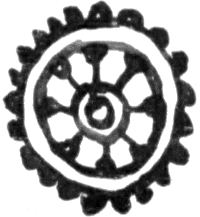- Learn how to form the perfect tense of any verbal root in both the parasmaipadam and ātmanēpadam.
- Familiarize yourself with the declension of changeable stems that end in s, including perfect parasmaipadam participles and comparative adjectives.
The perfect
s-stem adjectives
Comparison
1. Perfect forms
Conjugate the given verbs in the perfect tense in their entirety (i.e., all 9 forms of the parasmaipadam and all 9 forms of the ātmanēpadam). Recall that the second person singular parasmaipadam will usually have two possibilities, depending on whether or not the augment i is used.
- √kr̥ “do”
- √nī “lead”
- √vac “speak”
- √muc “release”
- √bhid “break”
- √bhū “become” (only parasmaipadam)
- √tan “stretch”
- √śru “hear”
- √krī “buy”
- √jñā “know”
- √dhā “place”
- √vid “know” (only parasmaipadam)
- √as “be” (only parasmaipadam)
- √vr̥dh “grow” (only ātmanēpadam)
- √man “think” (only ātmanēpadam)
- √ās “sit”
- √gaṇ “count”
- √īkṣ “look at”
- √cint “think about”
- √īh “strive”
2. Perfect forms
Translate the following short sentences into Sanskrit using a perfect verb.
- Arjuna said.
- She knows.
- They (du.) did it.
- They (pl.) say.
- They were born.
- Where did he go?
- They (du.) killed each other.
- They (pl.) went.
- He thought.
- The gods saw.
3. Sanskrit to English
Translate the following sentences into English.
- ārabdhē samarē parasparaṁ dr̥ṣṭvā śatrusēnē tasthatuḥ
- kim ūcuḥ pūrvācāryā iti śaśaṅkē rājā
- svakr̥taṁ punaḥpunaś cintya digantaṁ dadarśa
- bāḍham iti gurujanāḥ tac chaśaṁsuḥ yad uvāca vadhūḥ
- tatra gantavya ity amuṁ munir nirdidēśa parvatam
- tacchrutvā tuṣṭamanaskē bhikṣuṇyau tatparvataṁ jagmatuḥ
- tatra kālē kaścid acintyaśaktiḥ kavir utpēdē
- kēcit khaḍgān bibhrataḥ puruṣāḥ gr̥hē niṣīdataḥ tasya dr̥ṣṭigōcarē pētuḥ
- sōmaṁ krītvartvijaḥ yaṣṭum ārēbhirē
- Note: sōmaḥ is an herb (commonly identified as ephedra) that was used in Vedic sacrifices. It was soaked and pressed to make a drink.
- aśaṅkyabalō ’jitasēnō ’jātaśatrū rājānyān rājñō jigāya
- yad ēva cakārāyaṁ vēdajñō munis tad ēvāsya putrāḥ cakruḥ
The following two verses are from the fourteenth chapter of Bhaṭṭi’s Poem (Bhaṭṭikāvyam or Rāvaṇavadhaḥ), which exemplifies the use of the perfect tense.
-
śuśrāva rāmas tat sarvaṁ pratasthē ca sasainikaḥ
visphārayāṁ cakārāstraṁ babandhātha ca bāṇadhī(Bhaṭṭikāvyam 14.17)
- pra-√sthā (1st class, ubhayapadi) “advance”
- sainika- m. “soldier”
- vi-√sphr̥ (10th class, parasmaipadi) “draw”
- astra- n. “weapon”
- √bandh (7th class, parasmaipadi) “bind, tie on”
- atha indecl. particle “then, subsequently”
- bāṇa-dhi- m. “arrow-holder,” “quiver” (upapadatatpuruṣaḥ)
-
īkṣāṁ cakrē ’tha saumitrim anujajñē balāni ca
namaścakāra dēvēbhyaḥ parṇatalpaṁ mumōca ca(Bhaṭṭikāvyam 14.18)
- saumitri m. son of Sumitrā, Lakṣmaṇa
- sainika- m. “soldier”
- anu-√jñā (9th class, ubhayapadi) “take leave of”
- bala- n. “strength” or “army”
- namas-√kr̥ (8th class, parasmaipadi) “salute”
- parṇa-talpa- m. “leaf-bed”


